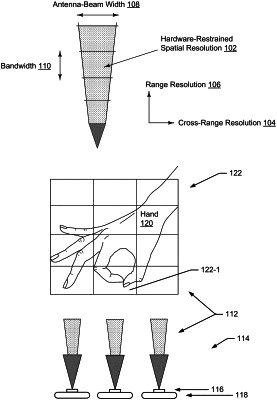| CPC G06F 3/017 (2013.01) [G01S 7/415 (2013.01); G01S 13/58 (2013.01); G01S 13/66 (2013.01); G01S 13/88 (2013.01); G01S 13/89 (2013.01); G06F 3/011 (2013.01)] | 20 Claims |

|
1. A computer-implemented method for gesture recognition, the computer-implemented method comprising:
receiving first reflections of a radar field off first and second points of a single non-rigid target at a first time, the first and second points corresponding to first and second Doppler centroids, respectively, the first and second Doppler centroids having higher energies than Doppler centroids corresponding to another point of the single non-rigid target, and the first and second points moving relative to one another within the radar field;
determining, based on the first reflections, a first relative velocity between the first and second points at the first time;
receiving second reflections of the radar field off the first and second points at a second time;
determining, based on the second reflections, a second relative velocity between the first and second points at the second time; and
determining, based on the first and second relative velocities, a gesture performed by the single non-rigid target.
|